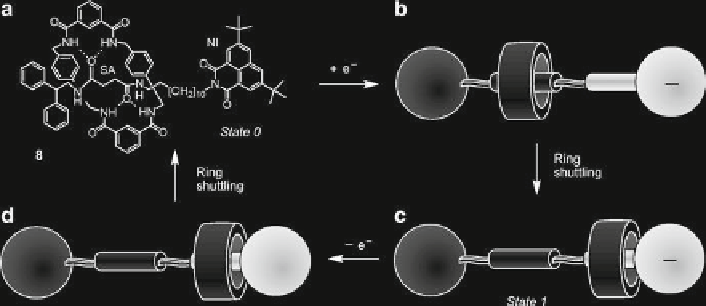Biomedical Engineering Reference
In-Depth Information
Fig. 6
Schematic representation of the operation of the electrochemically driven molecular shuttle 8
followed by ring shuttling to the original SA station. The occurrence of these processes
was demonstrated by cyclic voltammetric experiments and confi rmed by fl ash pho-
tolysis. Additionally, these techniques provided information on the dynamics of ring
shuttling. Other kinds of electrochemically driven molecular shuttles have been
reported (Balzani et al.
2000a
;
2003
;
2001a,
b
; Tseng et al.
2004
) .
3.2.3
Molecular Shuttles Powered by Light Energy
The design and construction of molecular shuttles powered exclusively by light
energy is a fascinating yet challenging subject. Rotaxane
9
6+
(Fig.
7
) was specifi cally
designed to achieve photoinduced ring shuttling. This compound is made of the elec-
tron donor macrocycle R, an axle component which contains a ruthenium(II) poly-
pyridine complex (P) as one of its stoppers, a
p
-terphenyl-type rigid spacer (S), a
4,4¢-bipyridinium unit (A
1
), and a 3,3¢ -dimethyl-4,4 ¢-bipyridinium unit (A
2
) as elec-
tron accepting stations, and a tetraarylmethane group as the second stopper (T). The
stable translational isomer of rotaxane
9
6+
(state 0) is the one in which the R compo-
nent encircles the A
1
unit, in keeping with the fact that this station is a better electron
acceptor than the other one. The strategy devised in order to obtain the photoinduced
abacus-like movement of the R macrocycle between the two stations A
1
and A
2
,
illustrated in the bottom part of Fig.
7
, is based on the following four operations.
(a)
Destabilization of the stable translational isomer
: Light excitation of the photo-
active unit P (process 1) is followed by the transfer of an electron from the
excited state to the A
1
station, which is encircled by the ring R (process 2), with
the consequent “deactivation” of this station; such a photoinduced electron
transfer process has to compete with the intrinsic decay of *P (process 3).
(b)
Ring displacement
: The ring moves by Brownian motion (process 4) from the
reduced A
1
station to A
2
(state 1), a step that has to compete with the back electron

